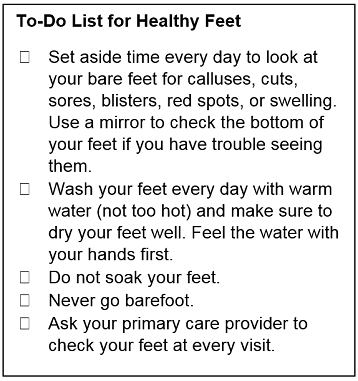Take Good Care of Your Feet

Think about all the places your feet take you every day. You use your feet to take a walk in the park or go out with your loved ones, play with your grandchildren, take care of your garden, and go dancing. What would your life be like without your feet? Diabetes puts the health of your feet and legs at risk. Avoid serious problems by taking care of them every day.
How Can Diabetes Hurt Your Feet?
Diabetes can reduce the blood flow to certain areas of your body, especially your legs and feet. This makes it harder for your body to heal from injuries. When you have diabetes, you can lose feeling in your feet. This can make it hard for you to tell if you have a problem or injury that needs to be treated, like a blister, sore, callus, or cut.
Diabetes is also the main cause for the loss of a toe, foot, or leg not caused by an accident. The good news is that nearly half of these cases can be prevented if people take care of their feet every day.
Learn the signs that could mean you have foot problems:
- Pain in your legs or cramping in your buttocks, thighs, or calves during physical activity
- Tingling or burning in your feet
- Numbness
- A change in the shape of your feet over time
- Hair loss on your toes, feet, and lower legs
- Dry and cracked skin on your feet
- A change in the color and temperature of your feet
- Thick, yellow toenails
- Blisters, sores, ulcers, infected corns, or ingrown toenails
- Fungus infections such as athlete’s foot between your toes
If you have any of these symptoms, call your doctor or podiatrist (foot doctor) as soon as possible.
What Can You Do To Protect Your Feet?

You can avoid or delay foot problems if you manage your diabetes and take good care of your feet. Here are some important steps you should take to protect your feet:
- Keep your blood pressure, blood sugar, and cholesterol at the levels recommended by your doctor.
- Don’t smoke, and if you do smoke, quit. Smoking reduces blood flow to the feet.
- Eat more fruits and vegetables.
- Be physically active every day and maintain a healthy weight.
- Take your medicines even when you feel good.
- Have a podiatrist check your feet at least once a year.
- Ask your podiatrist to share your test results with your health care team after every visit.
Print out the to-do list to the right and put it on your refrigerator or nightstand as a reminder of the things you can do to keep your feet healthy.
Remember to always wear shoes that are comfortable and that fit well. Do not wear shoes that are a bit tight or that rub or pinch your feet; these will give you blisters. Wear socks or stockings with your shoes when possible and try not to walk barefoot or to wear just socks. Put on some slippers while you are at home.
For more tips on how to keep your feet healthy, check out Diabetes and You: Healthy Feet Matter! [PDF – 460KB]
Protect Your Feet so You Can Be Physically Active
Walking is a great physical activity option. If you have not been active in a while, don’t worry! Start at a comfortable level and add a little more activity slowly as you go along. You can start by walking slowly for 10 minutes a day on a few days during the first couple of weeks. Then, as you start to feel comfortable with that, you can add more time and days or walk faster. For example, you can walk for 15 minutes a day, instead of 10, and on more days a week. Some people find it more fun to do physical activity with a friend or loved one. If that sounds like you, find someone who can join you as you get more active.
If you can’t walk easily, ask your doctor about other things you can do to exercise your feet and legs. Be Active Your Way: A Guide for Adults [PDF – 1.07MB] shares more information and tips on how you can fit physical activity into your life.
- Page last reviewed: August 16, 2017
- Page last updated: August 16, 2017
- Content source:
- Maintained By:


 ShareCompartir
ShareCompartir